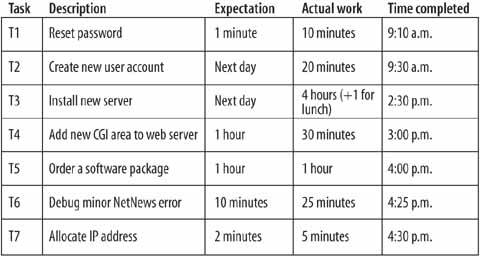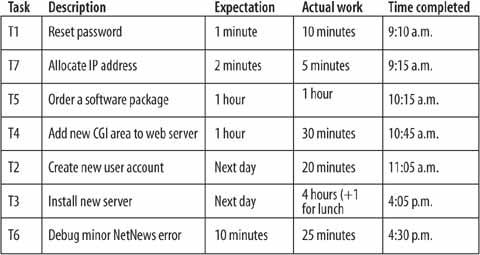Hack45.Prioritize Your Work
Hack 45. Prioritize Your Work
Perhaps no one in the company needs to learn good time management more than system administrators, but they are sometimes the last people to attempt to organize their work lives. Like most system administrators, you probably find it next to impossible to keep up with the demands of your job while putting in just 40 hours a week. You find yourself working evenings and weekends just to keep up. Sometimes this is fun, as you get to work with new technologiesand let's face it, most sysadmins like computers and often work on them even in their free time. However, working 60-hour weeks, month after month, is not a good situation to be in. You'll never develop the social life you crave, and you won't be doing your company a service if you're grouchy all the time because of lack of sleep or time away. But the work keeps coming, and you just don't see how you'll ever be able to cram it all into a standard work week…which is why you need this hack about task prioritization. I know, it's not really a hack about Linux servers, but it is a hack about being a sysadmin, which means it should speak directly to everyone reading this book. 4.18.1. Prioritizing TasksManaging your tasks won't only ensure you get everything done in a timely manner. It will also help you make better predictions as to when work can be done and, more importantly, it will make your customers happier because you'll do a better job of meeting their expectations about when their requests will be met. The next few sections discuss the methods you can use to order your tasks. 4.18.1.1. Doing tasks in list order.One method for ordering your tasks is to not spend time doing it. Make the decision simple and just start at the top of the task list and work your way down, doing each item in order. In the time you might have spent fretting about where to start, chances are you'll have completed a couple of smaller items. In addition, because the first items on the list are usually tasks you couldn't complete the previous day, you'll often be working on the oldest items first. Doing your to-do items in the order they appear is a great way to avoid procrastination. To quote the Nike advertisements, "Just do it." If your list is short enough that you can get through all the items in one day, this scheme makes even more senseif it doesn't matter if a task gets done early in the day or late in the day, who cares in what order it's completed? Of course, that's not often the case… 4.18.1.2. Prioritizing based on customer expectations.Here's a little secret I picked up from Ralph Loura when he was my boss at Bell Labs. If you have a list of tasks, doing them in any order takes (approximately) the same amount of time. However, if you do them in an order that is based on customer expectations, your customers will perceive you as working faster. Same amount of work for you, better perception from your customers. Pretty cool, huh? So what are your customer expectations? Sure, all customers would love all requests to be completed immediately, but in reality they do have some conception that things take time. User expectations may be unrealistic, and they're certainly often based on misunderstandings of the technology, but they still exist. We can place user expectations into a few broad categories:
Now that we understand our customers' expectations better, how can we put this knowledge to good use? Let's suppose we had the tasks shown in Figure 4-4 on our to-do list. Figure 4-4. Tasks that aren't prioritized by customer expectations If we did the tasks in the order listed, completing everything on the day it was requested in six and a half hours of solid work (plus an hour for lunch), we could be pretty satisfied with our performance. Good for us. However, we have not done a good job of meeting our customers' perceptions of how long things should have taken. The person that made request "T7" had to wait all day for something that he perceived should have taken two minutes. If I was that customer, I would be pretty upset. For the lack of an IP address, the installation of a new piece of lab equipment was delayed all day. (Actually, what's more likely to happen is that the frustrated, impatient customer wouldn't wait all day. He'd ping IP addresses until he found one that wasn't in use at that moment and "temporarily borrow" that address. If this were your unlucky day, the address selected would conflict with something and cause an outage, which could ruin your entire day. But I digress….) Let's reorder the tasks based on customer perceptions of how long things should take. Tasks that are perceived to take little time or to be urgent will be batched up and done early in the day. Other tasks will happen later. Figure 4-5 shows the reordered tasks. Figure 4-5. Tasks ordered based on customer expectations We begin the day by doing the two tasks (T1 and T7) that customers expect to happen quickly and that will hold up other, larger, projects. We succeed in meeting the perceived amount of time that these tasks should take, and everyone's happy. 4.18.2. Prioritizing ProjectsThe previous section described ways to prioritize individual tasks. Now I'll present some useful techniques for prioritizing projects. 4.18.2.1. Prioritization for impact.Let's say that you and your fellow sysadmins brain-stormed 20 great projects to do next year. However, you only have the budget and manpower to accomplish a few of them. Which projects should you pick? It's tempting to pick the easy projects and do them first. You know how to do them, and there isn't much controversy surrounding them, so at least you'll know that they'll be completed. It's also very tempting to pick out the fun projects, or the politically safe projects, or the projects that are the obvious next steps based on past projects. Ignore those temptations, and find the projects that will have the biggest positive impact on your organization's goals. It's actually better to do one big project that will have a large positive impact than many easy projects that are superficialI've seen it many times. Also, an entire team working on one goal works better than everyone having a different project, because we work better when we work together. Here's another way to look at it. All projects can fit into one of the four categories listed in Figure 4-6. Figure 4-6. Project impact versus effort Doing category A projects first seems like the obvious course. An easy project that will have a big impact is rare, and when such projects magically appear in front of us, doing them always looks like the right choice. (Warning: Be careful, because their A status may be a mirage!) It's also obvious to avoid category D projects. A project that is difficult and won't change much shouldn't be attempted. However, most projects are either in category B or C, and it's human nature to be drawn to the easy C projects. We can fill our year with easy projects, list many accomplishments, and come away looking very good. However, highly successful companies train management to reward workers who take on category B projectsthe difficult but necessary ones. If you think about it in terms of Return on Investment (ROI), it makes sense. You're going to spend a certain amount of money this year. Do you spend it on many small projects, each of which will not have a big impact? No, you look at what will have the biggest positive impact and put all your investment into that effort. It's important to make sure that these "big-impact" projects are aligned with your company's goalsimportant for the company and important for you too. You will be more highly valued that way. 4.18.2.2. Prioritizing requests from your boss.If your boss asks you to do something, and it's a quick task (not a major project), do it right away. For example, if your boss asks you to find out approximately how many PCs are running the old version of Windows, get back to her with a decent estimate in a few minutes. It helps to understand the big picture. Usually, such requests are made because your boss is putting together a much larger plan or budget (perhaps a cost estimate for bringing all PCs up to the latest release of Windows), and you can hold up her entire day by not getting back to her quickly with an answer. Why does this matter? Well, your boss decides what happens at your next salary review. Do I need to say more? Maybe I do. Your boss will have a fixed amount of money to dole out for all raises. If she gives more to Moe, Larry is going to get less. When your boss is looking at the list of people on the team, do you want her to look at your name and think "he sure did get me an estimate of the number of out-of-date Windows PCs quickly. Gosh, he always gets me the things I need quickly." Or do you want your boss to be thinking "you know, the entire budget was held up for a day because I was waiting for that statistic." Or worse yet "all the times I looked foolish in front of my boss because I was late, it was because I was waiting for [insert your name here] to get me a piece of information. So-and-so isn't getting a good raise this year." Keeping the boss happy is always a good idea! 4.18.3. SummaryManaging your priorities ensures that you meet your customers' expectations and get the work with the biggest impact done in a timely manner. However, prioritization is just one part of a time-management solution. Though you can go to general time-management books for more ideas, I humbly suggest a reading of my book, Time Management for System Administrators (O'Reilly). Tom Limoncelli |
EAN: 2147483647
Pages: 162